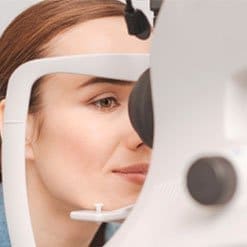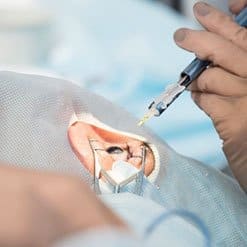Construction of the eye
Introduction
It all started with a cell that was sensitive to light and could distinguish between brightness and darkness . The adventure of sight in the process of evolution began 800 million years ago. According to the Swedish biologists Dan Nilson and Susanne Pelger ( Zoologiske Institutionen , Helgonavägen 3 , S -223 62 Lund , Sweden) if we go back for some 400,000 generations back , it turns out that the only this light-sensitive cell is the source of all the organs of sight, with which all living creatures are equipped with , including the human. Various creatures according to their own needs have developed different methods of vision . For example, herbivorous creatures have eyeballs on rear sides of the head, which increases the chances of survival and defense , because it gives the animals a wide field of view , allowing them to spot predators early enough to escape. For the same reasons in carnivores , including a human , the eyes are set at the front so as to provide a three-dimensional or spatial vision . An important element in determining the survival of the species was their ability to judge the distance to the victim. In the case of humans , evolution followed the same path as in other land mammals, whose anatomy and physiology are quite similar to ours.
Cornea
Cornea – the transparent, non-vascular structure , rich in nerve endings – is, from the functional point of view, the first and most important optical component of the visual system. Seen at a very high magnification, the cornea consists of five layers, where only the outer layer, the epithelium, has 5-6 cell layers of different thicknesses. The outer cells are continually being replaced by those lying deeper. Therefore , a scratch on the surface of the cornea, although usually quite painful, can heal in a few hours.
Lens
It is a small, fibrous , a biconvex lens , with thickness of approximately 3.6 mm. Its front surface is about 3 mm from the rear surface of the cornea; radius of curvature at the center is 10 mm and the closer edge, the curvature flattens more . The radius of curvature of the posterior surface is only 6 mm , so that the rear surface is much more rounded than the front . Apart from the surface curvature of the lens, refractive properties of lens are due to its structure , consisting of concentric rings , whose surfaces have progressively larger radius of curvature and degree of refraction, the closer to the nucleus they are The purpose of the lens is to change the power -breaking when looking at objects at different distances from the eye. When a person looks at something that is close, the lens must change its curvature in order to precisely focus on the object, which is a projection on the retina . When the muscles in ciliary body (part of the uveal tract ) contract, the lens zonular tension is reduced , the lens due to the fact that it is flexible,changes its curvature, and as a result its focusing ability.
Aqueous /humor/
The name “watery fluid” means the fluid present in the anterior chamber of the eye between the cornea, the iris and the lens. Fluid is continuously produced in the process of secretion and filtration of the ciliary body, its main function is to maintain the internal pressure of the eye at the appropriate power level, and support nutrition of the cornea and lens.
Iris
The iris is the coloured membrane placed behind the cornea and the front of lens. It is a round shape with a hole in the center – pupil – which acts as a shutter. The main task of the iris is dosing the amount of light that enters the eye. The tension of muscle fiber makes the pupil narrow or expand. The colour of iris depends on the amount of melanin pigment on the front and rear surfaces. The task of brown pigment is to absorb light reflected in the eye, and if the amount of the pigment on the rear surface is very small, the iris is blue, while increasing the amount of the pigment makes the colour beer or brown . If the pigment is located on the front surface, the iris becomes green.
Uvea
The uvea is a vascularized membrane having a structure ,which is formed by choroid of the eye in the rear and ciliary body together with iris in the front section. By reducing the pupil diameter , the amount of light entering the eye is decreased at the same time. When the pupil narrows, the vision is clearer and distortion on the outskirts is minimized. Conversely, when the pupil expands, visual acuity decreases.
Vitreous
itreous consists of a transparent, jelly-like substance that fills the whole, a fairly large cavity between the rear of the lens and the retina. The main function it plays is maintaining adherence of the retina to pigment epithelium; the optical function is not very significant
Retina
Retina is the sensitive membrane, similar to photographic film and consists of three parts: a colour layer, vascular layer and a layer consisting of nerve fibers together with retinal photoreceptors (rods and suppositories). The retina suppositories (6 million in the human eye) are located mostly in the central part of the retina, called the macula , in the center of: which there is a small hole, called fovea. Approximately 120 million rods are located mainly in the peripheral retina. When the focused image falls on the retina, there is a range of physical, chemical and electrical processes going on , during which through the optic nerve, the information reaches the part of the visual cortex, where it is corrected and processed.






